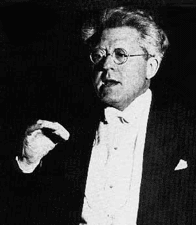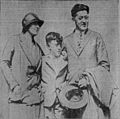Artur Rodziński facts for kids
Quick facts for kids
Artur Rodziński
|
|
|---|---|
 |
|
| Background information | |
| Born | 1 January 1892 Split, Kingdom of Dalmatia, Austria-Hungary |
| Died | 27 November 1958 (aged 66) Boston, Massachusetts, U.S. |
| Genres | Classical |
| Occupation(s) | Conductor |
| Associated acts | Chicago Symphony Cleveland Orchestra Los Angeles Philharmonic New York Philharmonic |
Artur Rodziński (born January 1, 1892 – died November 27, 1958) was a famous Polish conductor. He led many orchestras and operas. He is best known for leading the Cleveland Orchestra and the New York Philharmonic in the 1930s and 1940s.
Contents
Biography
Early Life and Musical Start
Artur Rodziński was born in Split, a city in what is now Croatia, on January 2, 1892. His father was a general. The family soon moved to Lwów, Poland. Artur started studying music there.
Later, he also studied law in Vienna, Austria. At the same time, he went to the Academy of Music. He learned about composing, conducting, and playing the piano from famous teachers.
He returned to Lwów and became a chorus master at the Opera. He first conducted an opera called Ernani in 1920. The next year, he conducted the Warsaw Philharmonic Orchestra.
A famous conductor named Leopold Stokowski heard Rodziński conduct. He said, "I have found that rare thing, a born conductor!" Stokowski then invited him to conduct the Philadelphia Orchestra in the United States.
Leading Orchestras in America
From 1925 to 1929, Rodziński worked as Stokowski's assistant. He also conducted for the Philadelphia Grand Opera. He taught opera and orchestra at the Curtis Institute of Music.
From 1929 to 1933, Rodziński was the music director of the Los Angeles Philharmonic.
The Cleveland Orchestra
In 1933, Rodziński became the second music director of The Cleveland Orchestra. He was a very demanding conductor. He pushed the orchestra to be even better. He often conducted without a music score or a baton, which impressed the audience.
Rodziński helped the Cleveland Orchestra perform more operas. He also wanted them to play more modern music. This included works by composers like Claude Debussy, Maurice Ravel, and Dmitri Shostakovich. He even led the first Cleveland performance of Stravinsky’s famous ballet, Le Sacre du Printemps.
In 1935, under Rodziński, the Orchestra performed the first U.S. show of Shostakovich’s opera, Lady Macbeth of Mtsensk. This was only a year after it first played in the Soviet Union. Shostakovich himself trusted Rodziński's performance. He said, "You will see no traditional opera." The performances were a big success.
The Orchestra also made famous recordings with Rodziński. One was of Jerome Kern's musical Show Boat in 1941.
World War II and New York
On December 7, 1941, Rodziński was conducting the New York Philharmonic. This was the day Japan attacked Pearl Harbor. He didn't announce the news during the live radio broadcast. Instead, he led the orchestra in playing the Star-Spangled Banner.
Later, he suggested that orchestras should hire women. He believed women would be "an excellent addition to any first class symphony orchestra." This was because many young men were going to fight in World War II.
Between 1939 and 1942, Rodziński and The Cleveland Orchestra made many recordings. He also conducted the New York Philharmonic several times. He received good reviews for his performance of Richard Strauss's Elektra.
Rodziński also worked in Europe. He was the first American citizen to conduct the Vienna Philharmonic at the Salzburg Festival in 1936 and 1937.
Arturo Toscanini, another famous conductor, asked Rodziński to help choose musicians for the new NBC Symphony Orchestra. Rodziński trained this orchestra and led some of its first concerts. This led him to leave Cleveland and become the music director of the New York Philharmonic in 1943.
New York and Chicago
Rodziński became the music director of the New York Philharmonic in 1943. He stayed for four years. Even though he had disagreements with the orchestra's manager, Arthur Judson, the orchestra played wonderfully.
A famous music critic, Virgil Thomson, wrote that the orchestra was "a joy to hear." He gave credit to Artur Rodziński for this. During this time, the Philharmonic made many recordings. They also performed weekly live on CBS Radio. They even appeared in a movie called Carnegie Hall.
However, Rodziński and the manager disagreed on many things. These included who the music director could fire, which soloists to choose, and what music to play. Rodziński did not want to compromise. So, he resigned in 1947. His resignation was so important that it was a cover story in Time magazine.
The Chicago Symphony Orchestra had wanted Rodziński for a while. He decided to lead that orchestra starting in the 1947–1948 season. But again, he had trouble working with the orchestra's board. He left after only one season. Still, his time there was important. He led great performances, like Wagner's Tristan und Isolde.
Later Years
After leaving Chicago, Rodziński's health started to get worse. He moved back to Europe. There, he was still seen as a very important musician. He was invited to lead big productions. This included the first performance of Prokofiev's War and Peace in Florence in 1953.
He conducted at La Scala, a famous opera house. He also worked a lot for Italian radio. He conducted well-loved performances of Wagner's Tannhäuser and Tristan. He also conducted Mussorgsky's Boris Godunov.
He started recording again with Westminster Records in 1955. He recorded many pieces with the Royal Philharmonic Orchestra. His last recordings were for EMI in 1958.
By this time, Rodziński's health was very weak. His doctor warned him that more conducting could be dangerous. However, he returned to Chicago in 1958 to conduct Tristan one last time. He led the Chicago Lyric Opera with the singer Birgit Nilsson. His return was a huge success. These were his final performances. He died shortly afterward.
Family
Rodziński was married twice and had two sons. In 1917, he married concert pianist Ilse. In 1918, they had a son, Witold. Witold later became a historian and diplomat.
In 1934, while living in Cleveland, Artur married Halina Lilpop Wieniawski (1905-1993). She was from a well-known family in Warsaw.
Their son, Richard, was born later. Richard worked for opera companies like the San Francisco Opera and Metropolitan Opera. He recently retired from leading the Van Cliburn Foundation. In 2009, he became the General Director of the International Tchaikovsky Competition. In 1976, Halina Rodziński wrote a book about their lives called Our Two Lives. It is the most detailed book about Rodziński's life.
Recordings
Rodziński made recordings for several companies. These included Columbia Records, RCA Victor, Westminster Records, and EMI. Some of his later recordings were made in stereo. These recordings are still available today.
His complete recording of Tchaikovsky's The Nutcracker was made in stereo in 1956. It was re-released on compact disc in 2001.
Live recordings of his concerts have also been released. These include performances with the New York Philharmonic. His highly praised 1937 concert of Strauss's Elektra was restored. It was released on CD in 2014.
Images for kids
See also
 In Spanish: Artur Rodziński para niños
In Spanish: Artur Rodziński para niños



